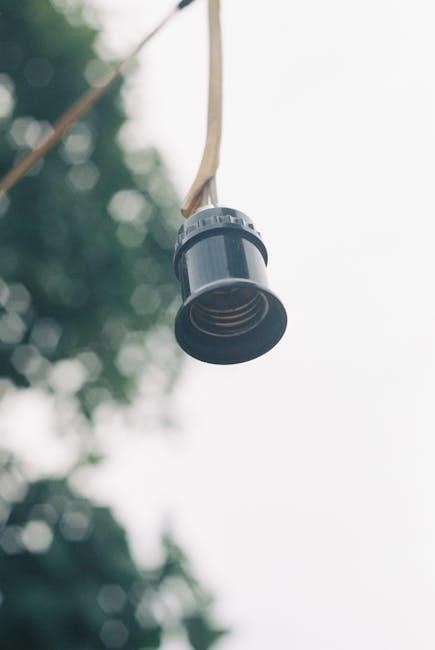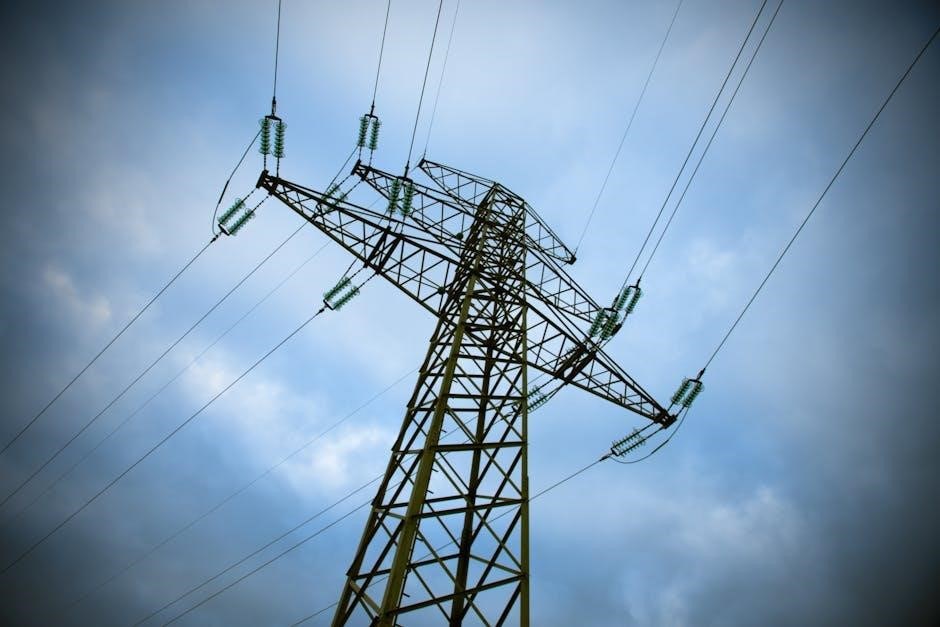electrical cable gland size chart pdf
An electrical cable gland size chart provides essential guidance for selecting the correct gland based on cable diameter, material, and application, ensuring safety, reliability, and compliance with industry standards. These charts are available in PDF format for easy offline access during installations.
1.1 What is an Electrical Cable Gland?
An electrical cable gland is a mechanical device that secures and protects cables where they enter electrical equipment. It provides strain relief, environmental sealing, and ensures a safe connection. Made from materials like brass, stainless steel, or nylon, cable glands are used across industries such as automation, construction, and energy. They are essential for maintaining the integrity and safety of cable installations, and their selection is guided by cable gland size charts to ensure compatibility and performance.
1.2 Importance of Proper Gland Size Selection
Proper gland size selection is crucial for ensuring safety, reliability, and long-term performance in electrical installations. Incorrect gland sizes can lead to safety hazards, performance issues, and premature wear. Using a cable gland size chart PDF helps in accurately matching the gland to the cable’s diameter and type, ensuring a secure and durable connection. This step is vital for maintaining the integrity of electrical systems and complying with industry standards like BS 5467.
1.3 Overview of the Cable Gland Size Chart PDF
The cable gland size chart PDF serves as a comprehensive guide for selecting the correct gland size based on cable diameter, material, and application. It includes detailed tables listing minimum and maximum cable diameters for various gland sizes and types, such as armoured and unarmoured cables. The PDF is designed for offline accessibility, ensuring easy reference during on-site installations. It also covers industry standards like BS 5467, making it a versatile tool for engineers and installers to ensure safe and reliable electrical connections.

Understanding Cable Gland Sizes and Types
Understanding cable gland sizes and types is crucial for ensuring safe and reliable electrical connections. This section explores various gland types, their materials, and applications.
2.1 Cable Gland Size Selection Based on Cable Diameter
Selecting the correct cable gland size based on cable diameter is crucial for ensuring safe and reliable electrical connections. The size chart provides a guide to match gland sizes with specific cable diameters, ensuring proper fitment and sealing. For example, a 50mm cable bundle requires a 50mm gland. Always measure the cable accurately and refer to the chart for precise selection to avoid installation issues.
2.2 Types of Cable Glands: Armoured, Unarmoured, and Double Compression
Armoured cable glands are designed for cables with metal or synthetic armour, providing enhanced protection in harsh environments. Unarmoured glands are suitable for non-armoured cables and are ideal for indoor or less demanding applications. Double compression glands offer superior sealing and strain relief, making them perfect for high-stress environments. Each type is tailored to specific cable requirements, ensuring optimal performance and safety in various installations.
2.3 Specialized Glands: Wiping Glands, BW Type, CW Type, A1/A2 Type, and ALCO Type
Wiping glands are designed for sealing and protecting cables in hazardous environments. BW type glands are suitable for braided cables, while CW type glands cater to corrugated or armored cables. A1/A2 type glands are ideal for armored cables with specific core counts, and ALCO type glands are used in high-risk areas requiring advanced sealing. Each specialized gland type ensures optimal performance and safety in diverse industrial applications.

How to Read the Cable Gland Size Chart
Match the cable diameter to the gland size using the chart. Understand Group A and Group B classifications for core counts. Ensure compliance with BS 5467 standards for accurate selection.
3.1 Interpreting Minimum and Maximum Cable Diameters
The cable gland size chart lists minimum and maximum cable diameters for each gland size. Match your cable’s diameter to these ranges to ensure a proper fit. The chart is organized by gland type, such as armoured or unarmoured, and includes specific measurements for XLPE and PVC insulated cables. Always verify the cable’s actual diameter against the chart to avoid sizing errors. This ensures safe and reliable electrical connections, complying with industry standards like BS 5467.
3.2 Understanding Group A and Group B Classifications
The Group A and Group B classifications in the cable gland size chart categorize cables based on their core count and diameter. Group A typically includes cables with fewer cores and smaller diameters, while Group B covers those with more cores and larger diameters. These groups help users quickly identify the appropriate gland size for their specific cable configuration, ensuring precise and safe installations. The chart provides clear guidelines for each group, simplifying the selection process and ensuring compliance with standards like BS 5467.
3.3 Matching Cable Core Count to Gland Size
Matching the cable core count to the correct gland size is crucial for ensuring proper installation and safety. The cable gland size chart organizes cables by core count, from 1 core to 48 cores, and provides corresponding gland sizes. For example, a 2 X 1.5mm cable typically uses a 12mm gland, while a 4 X 16mm cable requires a 28mm gland. Always measure the cable and refer to the chart to ensure accurate selection and compliance with standards like BS 5467.

Factors Affecting Cable Gland Size Selection
Cable material, environmental conditions, and industry standards like BS 5467 influence gland size selection, ensuring proper, safe, and reliable installations and compliance.
4.1 Cable Material and Construction
Cable material and construction significantly impact gland size selection. PVC, XLPE, and SWA cables have varying diameters and flexibility, requiring specific gland sizes for proper sealing and mechanical protection. Armoured cables, with their additional protective layers, need larger glands to accommodate their increased diameter. The material’s properties, such as insulation thickness and core count, also influence the selection process, ensuring the gland fits securely without compromising the cable’s integrity or performance.
4.2 Environmental and Application-Specific Requirements
Environmental factors like temperature, humidity, and exposure to chemicals influence gland size selection. For instance, SWA cables in outdoor settings may require larger glands due to additional protective layers. Application-specific needs, such as high-voltage or hazardous area installations, demand glands with enhanced sealing properties. Ensuring compatibility with the cable’s operating conditions is crucial for maintaining performance and safety in diverse industrial and commercial settings.
4.3 Industry Standards and Regulations (e.g., BS 5467)
Compliance with industry standards like BS 5467 is critical for ensuring safety and reliability in cable gland installations. These standards provide guidelines for gland size selection based on cable diameter and construction. The PDF chart includes tables organized by gland size and type, helping users adhere to these regulations. While the chart offers guidance, precise measurements and cable specifications should always be verified to ensure full compliance with applicable standards.

Cable Gland Size Chart for Armoured Cables
The chart provides detailed size recommendations for armoured cables, including XLPE insulated and SWA/PVC types, ensuring proper gland size selection based on cable diameter and construction.
5.1 Size Recommendations for Armoured Cables
The size chart offers detailed recommendations for armoured cables, including XLPE insulated and SWA/PVC types. It lists minimum and maximum cable diameters for each gland size, ensuring proper fitment. The chart is organized by cable core count and diameter, making it easy to match armoured cables with the correct gland. Reference standards like BS 5467 are included for compliance. Always measure the cable before selection, as manufacturing tolerances may vary.
5.2 XLPE Insulated Armoured Cable Gland Sizes
The XLPE insulated armoured cable gland size chart provides precise sizing for various core configurations, such as 3.5 core, 4 core, and 5 core cables. It lists minimum and maximum diameters for each gland size, ensuring a secure fit. For example, a 3.5 core XLPE cable with a 35mm diameter typically requires a 32mm gland size. Always verify measurements against the chart to ensure compliance with standards like BS 5467.
5.3 SWA/PVC Armoured Cable Gland Size Selection
For SWA/PVC armoured cables, gland size selection is based on the cable bundle diameter. The chart provides specific recommendations, such as a 32mm gland for a 3.5 core, 35mm diameter cable and a 35mm gland for a 3.5 core, 50mm diameter cable. Always refer to the chart to ensure the selected gland matches the minimum and maximum diameters for your specific SWA/PVC cable, ensuring compliance with BS 5467 standards.

Cable Gland Size Chart for Unarmoured Cables
The chart provides size recommendations for unarmoured cables, ensuring proper gland selection based on cable core count and diameter. It includes guidance for PVC and XLPE insulated cables, with specific gland sizes for various core configurations, such as 1 core, 2 core, and 3.5 core cables. Always measure the actual cable diameter and compare it with the chart’s min/max values for accurate selection.
6.1 Size Recommendations for Unarmoured Cables
The size chart provides detailed recommendations for unarmoured cables, ensuring accurate gland size selection. It covers various cable types, including PVC and XLPE insulated cables, and offers guidance for different core counts such as 1 core, 2 core, 3.5 core, 4 core, 5 core, 7 core, 10 core, 12 core, 19 core, 27 core, 37 core, and 48 core. The chart lists minimum and maximum cable diameters for each gland size, helping users make precise selections. Always measure the actual cable diameter and compare it with the chart’s values for accurate gland size selection.
6.2 PVC and XLPE Insulated Unarmoured Cable Gland Sizes
The size chart provides specific recommendations for PVC and XLPE insulated unarmoured cables, ensuring accurate gland size selection. It lists minimum and maximum cable diameters for each gland size, organized by core count and cable type. For example, a 2 X 1.5mm cable corresponds to a 12mm (1/2″) gland, while a 4 X 16mm cable requires a 28mm (1.1/8″) gland. Always measure the actual cable diameter and compare it with the chart’s values for precise selection.
6.3 Core Count and Diameter Matching for Unarmoured Cables
The size chart simplifies selecting the correct gland size by matching the core count and cable diameter. For example, a 2 X 1.5mm cable corresponds to a 12mm (1/2″) gland, while a 4 X 16mm cable requires a 28mm (1.1/8″) gland. Always measure the actual cable diameter and compare it with the chart’s values to ensure accurate selection, as manufacturing tolerances may affect cable size.

Industry-Specific Applications of Cable Glands
Cable glands are widely used in industrial automation, construction, and energy systems to ensure safe and reliable cable connections. They provide strain relief and environmental sealing in diverse applications.
7.1 Cable Glands in Industrial Automation
In industrial automation, cable glands play a crucial role in protecting cables from harsh environments while maintaining reliable connections. They provide strain relief and environmental sealing, ensuring uninterrupted operations. Using a cable gland size chart helps in selecting the right gland for specific automation equipment, ensuring safety and compliance with industry standards. These glands are often made from durable materials like stainless steel or nylon to withstand demanding conditions in automated systems.
7.2 Cable Glands in Construction and Commercial Installations
Cable glands are essential in construction and commercial installations for protecting cables from environmental hazards. They provide sealing and strain relief, ensuring safety and reliability in high-traffic areas. Using a cable gland size chart helps in selecting the right gland for specific applications, ensuring compliance with industry standards. Durable materials like brass, stainless steel, or nylon are commonly used to withstand demanding conditions in these settings.
7.3 Cable Glands in Energy and Power Distribution Systems
Cable glands play a critical role in energy and power distribution systems, ensuring safety and reliability in harsh environments. They provide environmental sealing and strain relief, protecting cables in substations, transformers, and power grids. Durable materials like brass or stainless steel are often used to withstand extreme conditions. Using a cable gland size chart ensures proper selection, maintaining system integrity and preventing failures in critical power infrastructure.
Benefits of Using a Cable Gland Size Chart PDF
A cable gland size chart PDF offers offline accessibility, enabling quick and precise gland size selection. It ensures compliance with international safety standards and streamlines installation processes effectively.
8.1 Offline Accessibility for On-Site Installations
The electrical cable gland size chart PDF provides offline accessibility, making it an indispensable tool for engineers and installers working in remote or internet-limited environments. This ensures uninterrupted access to critical sizing information, enabling quick and accurate gland selection. The PDF format allows for easy storage on mobile devices, serving as a reliable reference during on-site installations. This feature is particularly valuable for maintaining efficiency and precision in field applications where internet connectivity may be unavailable.
8.2 Quick and Precise Gland Size Selection
The electrical cable gland size chart PDF enables quick and precise gland size selection by organizing data into easy-to-read tables. Users can match their cable’s diameter and core count to the appropriate gland size, minimizing errors. The chart lists minimum and maximum diameters for each gland size, ensuring compatibility and safety. This streamlined process saves time and reduces the risk of incorrect selections, making it an essential tool for engineers and installers.
8.4 Compliance with International Safety Standards
The electrical cable gland size chart PDF ensures compliance with international safety standards, such as BS 5467, by providing precise sizing guidelines. It organizes data to help users select glands that meet global safety and performance requirements. This ensures installations are reliable and safe, adhering to industry regulations. The chart’s structured format makes it easier to verify compliance, reducing risks and ensuring adherence to international standards for electrical installations.

How to Download the Electrical Cable Gland Size Chart PDF
Visit ExGrip.com to download the Electrical Cable Gland Size Chart PDF. Use the direct download button for quick access. Contact their team at 91 9537118899 for assistance.
9.1 Reliable Sources for Download
Reputable manufacturers like ExGrip offer free Electrical Cable Gland Size Chart PDF downloads. Visit their official website at www.exgrip.com or contact them at 91 9537118899 for direct access. Ensure the source is trusted to avoid incorrect or outdated information. The PDF includes detailed tables for armoured and unarmoured cables, making it a valuable resource for precise gland size selection. Always verify the chart’s relevance to your specific application before use.
9.2 Verifying the PDF for Accuracy and Relevance
Ensure the Electrical Cable Gland Size Chart PDF is accurate by checking it against industry standards like BS 5467. Review the tables for minimum and maximum cable diameters and confirm they align with your specific cable type (e.g., armoured or unarmoured). Verify the chart includes application-specific requirements and is updated to reflect current industry standards. If unsure, consult the manufacturer or supplier for confirmation.
9.3 Printing and Using the Chart for Field Applications
Print the Electrical Cable Gland Size Chart PDF on high-quality paper for clear visibility. Use the chart to quickly identify gland sizes based on cable diameters and types. Highlight relevant sections for easy reference during installations. Ensure the chart is laminated or protected from environmental factors to maintain its usability. Always cross-reference the chart with actual cable measurements to ensure accurate gland size selection and compliance with safety standards.

Common Mistakes to Avoid in Gland Size Selection
Common errors include ignoring cable diameter measurements, not considering environmental factors, and overlooking industry standards. Always verify cable dimensions and refer to the size chart for accurate selection.
10.1 Ignoring Cable Diameter Measurements
Ignoring cable diameter measurements is a critical mistake, as it can lead to improper sealing, environmental exposure, or mechanical stress. Always measure the cable bundle diameter accurately to ensure the gland fits correctly. Using the cable gland size chart helps match the gland size to the cable diameter, preventing installation errors. Each gland is designed for specific cable sizes and applications, so accurate measurement is essential for safety and performance. Refer to the chart to avoid mismatches and ensure reliable connections in industrial or commercial settings.
10.2 Overlooking Industry-Specific Requirements
Overlooking industry-specific requirements can lead to non-compliance with safety standards and performance issues. Different industries, such as industrial automation, construction, or energy systems, have unique demands for cable glands. For example, BS 5467 specifies standards for certain applications. Failing to consider these requirements can result in improper sealing, environmental hazards, or system malfunctions. Always consult the cable gland size chart and industry guidelines to ensure compliance and reliability in your specific application.
10.3 Not Considering Environmental Factors
Environmental factors like moisture, temperature, and chemical exposure significantly impact cable gland performance. Ignoring these can lead to sealing failures, compromising safety and reliability. For instance, glands used in high-temperature or corrosive environments require specialized materials. Always consult the cable gland size chart to ensure the selected gland meets environmental demands, preventing potential hazards and ensuring long-term system integrity. Proper selection is crucial for maintaining IP ratings and environmental sealing in harsh conditions.

Troubleshooting Cable Gland Size Selection
Incorrect gland sizes can lead to safety hazards and installation issues; Use the cable gland size chart to match gland sizes with cable specifications, ensuring precise and reliable connections.
11.1 Identifying Incorrect Gland Sizes
Incorrect gland sizes can lead to loose or tight fits, compromising safety and performance. Check for proper sealing and strain relief. If the gland does not align with the cable’s diameter or type, it may indicate a sizing error. Refer to the cable gland size chart to verify measurements and ensure compliance with industry standards like BS 5467. Always measure the cable diameter accurately to avoid mismatches.
11.2 Resolving Measurement Discrepancies
If discrepancies arise, cross-reference the cable gland size chart with actual measurements. Ensure the cable diameter falls within the chart’s specified range for the selected gland. Account for manufacturing tolerances, as slight variations may exist. Verify compliance with standards like BS 5467 and consult technical support if uncertainties persist. Accurate measurements and chart alignment are crucial for reliable installations and safety.
11.3 Adjusting for Manufacturing Tolerances
Manufacturing tolerances may cause slight variations in cable or gland dimensions. Always refer to the cable gland size chart for minimum and maximum diameter ranges. If discrepancies occur, select a gland that accommodates the cable’s actual size. Verify measurements and ensure compliance with standards like BS 5467. Adjustments may involve choosing the next suitable gland size to maintain a secure and reliable connection, ensuring long-term performance and safety.
Proper cable gland size selection ensures safety, reliability, and efficiency. Always refer to the PDF chart for accurate sizing and stay updated with industry standards for optimal performance.
12.1 Summary of Key Points
The electrical cable gland size chart PDF is a vital tool for ensuring safe and reliable installations. It provides detailed tables outlining minimum and maximum cable diameters for various gland sizes, helping users select the correct gland for their specific needs. The chart covers both armoured and unarmoured cables, with classifications like Group A and Group B to guide core count and diameter matching. Proper gland selection ensures compliance with industry standards like BS 5467 and prevents installation errors.
Always measure the cable accurately and consider environmental factors to ensure optimal performance. The PDF format allows offline access, making it indispensable for on-site applications. By following the chart, installers can achieve precise and efficient gland size selection, ensuring long-term system reliability and safety.
12.2 Final Tips for Effective Gland Size Selection
Always measure the cable diameter accurately and refer to the size chart for precise selection. Consider environmental factors and industry standards like BS 5467 to ensure compliance. Double-check the gland type (armoured or unarmoured) and verify manufacturing tolerances to avoid sizing mismatches. Use the PDF chart as a quick reference guide during installations, and consult technical experts if unsure. Proper selection ensures safety, reliability, and optimal system performance.
12.3 Importance of Staying Updated with Industry Standards
Staying updated with industry standards like BS 5467 ensures compliance, safety, and optimal performance in cable gland installations. Standards evolve to address new challenges, so regular updates are crucial. Using the latest cable gland size chart PDF guarantees adherence to current regulations, reducing risks and ensuring reliable connections. Always verify standards and updates to maintain high-quality electrical installations and avoid potential hazards.

